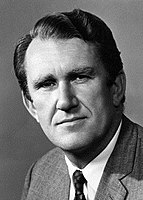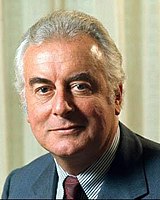1975 Australian federal election
| |||||||||||||||||||||||||||||||||||||||||||
All 127 seats of the House of Representatives 64 seats were needed for a majority in the House All 64 seats of the Senate | |||||||||||||||||||||||||||||||||||||||||||
|---|---|---|---|---|---|---|---|---|---|---|---|---|---|---|---|---|---|---|---|---|---|---|---|---|---|---|---|---|---|---|---|---|---|---|---|---|---|---|---|---|---|---|---|
| Registered | 8,262,413 | ||||||||||||||||||||||||||||||||||||||||||
| Turnout | 7,881,873 (95.39%) ( | ||||||||||||||||||||||||||||||||||||||||||
| |||||||||||||||||||||||||||||||||||||||||||
 Results by division for the House of Representatives, shaded by winning party's margin of victory. | |||||||||||||||||||||||||||||||||||||||||||
| |||||||||||||||||||||||||||||||||||||||||||
The 1975 Australian federal election was held in Australia on 13 December 1975. All 127 seats in the House of Representatives and all 64 seats in the Senate were up for election, due to a double dissolution.
Malcolm Fraser had been commissioned as caretaker prime minister following the dismissal of Gough Whitlam's three-year-old Labor government by Governor-General Sir John Kerr, on 11 November 1975. The same day, Fraser advised an immediate double dissolution, in accordance with Kerr's stipulated conditions (see 1975 Australian constitutional crisis).
The Coalition of Fraser's Liberal Party of Australia and Doug Anthony's National Country Party secured government in its own right, winning the largest majority government to date in Australian history.[a] The Liberals actually won a majority in their own right, with 68 seats–the first time that the main non-Labor party had done so since adopting the Liberal banner in 1944. Although Fraser had no need for the support of the National Country Party, the Coalition was retained. It was also the first time a party won over 90 seats at an Australian election. This was the last federal election the Coalition won more than 50% of the primary vote.
Labor suffered a 30-seat swing and saw its lower house caucus cut almost in half, to 36 seats—fewer than it had when Whitlam became leader in the aftermath of the Coalition landslide nearly 10 years earlier, in the 1966 election. With only 28% of the House of Representatives seats, this was the worst seat share for Labor since the current Liberal-Labor party contest from 1946.
Results
[edit]House of Representatives results
[edit]
Coalition
Liberal (68)
NCP (22)
CLP (1)
Opposition (36)
Labor (36)
- ^ While the Coalition under John Howard won 94 seats at the 1996 election, this only accounted for 63.51% of all seats in the House of Representatives, as there were 148 seats in 1996. The Coalition under Fraser won 91 seats, which, although smaller than 94, accounted for 71.65% of the House of Representatives, which had 127 seats in 1975. Therefore, while Howard won three more seats than Fraser in 1996, Fraser still won a larger majority.
| Party | Votes | % | Swing | Seats | Change | ||
|---|---|---|---|---|---|---|---|
| Liberal–NCP coalition | 4,102,078 | 53.05 | +7.32 | 91 | +30 | ||
| Liberal | 3,232,159 | 41.80 | +6.85 | 68 | +28 | ||
| National Country | 853,943 | 11.04 | +0.28 | 22 | +1 | ||
| Country Liberal | 15,976 | 0.21 | +0.21 | 1 | +1 | ||
| Labor | 3,313,004 | 42.84 | −6.46 | 36 | −30 | ||
| Democratic Labor | 101,750 | 1.32 | −0.10 | 0 | 0 | ||
| Workers | 60,130 | 0.78 | +0.78 | 0 | 0 | ||
| Liberal Movement | 49,484 | 0.64 | –0.14 | 0 | 0 | ||
| Australia | 33,630 | 0.43 | −1.89 | 0 | 0 | ||
| Communist | 9,393 | 0.12 | +0.11 | 0 | 0 | ||
| Independent | 63,109 | 0.82 | +0.42 | 0 | 0 | ||
| Total | 7,732,578 | 127 | |||||
| Two-party-preferred (estimated) | |||||||
| Liberal–NCP coalition | Win | 55.70 | +7.40 | 91 | +30 | ||
| Labor | 44.30 | −7.40 | 36 | −30 | |||
Senate results
[edit]
Coalition
Liberal (26)
NCP (8)
CLP (1)
Opposition (27)
Labor (27)
Crossbench (2)
Liberal Movement (1)
Independent (1)
| Party | Votes | % | Swing | Seats won | Seats held | Change | ||
|---|---|---|---|---|---|---|---|---|
| Liberal–NCP coalition (total) | 3,706,989 | 51.74 | +7.85 | 35 | 35 | +6 | ||
| Liberal–NCP joint ticket | 2,855,721 | 39.86 | +5.09 | 17 | * | * | ||
| Liberal | 793,772 | 11.08 | +3.26 | 16 | 26 | +3 | ||
| National Country | 41,977 | 0.59 | −0.71 | 1 | 8 | +2 | ||
| Country Liberal | 15,519 | 0.22 | +0.22 | 1 | 1 | +1 | ||
| Labor | 2,931,310 | 40.91 | −6.38 | 27 | 27 | −2 | ||
| Democratic Labor | 191,049 | 2.67 | −0.89 | 0 | 0 | 0 | ||
| Liberal Movement | 76,426 | 1.07 | +0.11 | 1 | 1 | 0 | ||
| Workers | 62,385 | 0.87 | +0.87 | 0 | 0 | 0 | ||
| Family Movement | 45,658 | 0.64 | +0.64 | 0 | 0 | 0 | ||
| Australia | 34,632 | 0.48 | –0.91 | 0 | 0 | 0 | ||
| United Tasmania | 1,227 | 0.02 | –0.01 | 0 | 0 | 0 | ||
| Socialist | 727 | 0.01 | +0.01 | 0 | 0 | 0 | ||
| Independents | 114,310 | 1.60 | –0.52 | 1 | 1 | 0 | ||
| Total | 7,164,713 | 64 | 64 | +4 | ||||
- Notes
- Independent: Brian Harradine (Tasmania)
Seats changing hands
[edit]- Members listed in italics did not contest their seat at this election.
Issues and significance
[edit]
The election followed the dismissal of the Whitlam government by Governor-General Sir John Kerr in the 1975 constitutional crisis. Labor campaigners hoped that the electorate would "maintain [its] rage" and punish the Coalition for its part in bringing down the government, proclaiming "Shame Fraser, Shame". However, the Coalition focused on economic issues following the 1973 oil crisis and 1973–75 recession, the Loans Affair, alleged Labor mismanagement of inflation, and campaigned under the slogan "Turn on the lights, Australia" (drawing on a contemporary cynicism: "Would the last businessman leaving Australia please turn out the lights?").[1][2]
The Australian Capital Territory and the Northern Territory received an entitlement to elect two senators each as a consequence of the Senate (Representation of Territories) Act 1973, passed during the 1974 Joint Sitting of the Australian Parliament.
See also
[edit]- Candidates of the Australian federal election, 1975
- Members of the Australian House of Representatives, 1975–1977
- Members of the Australian Senate, 1975–1978
References
[edit]- ^ Twomey, Anne (19 April 2017). "Australian politics explainer: Gough Whitlam's dismissal as prime minister". The Conversation. Archived from the original on 23 August 2023. Retrieved 23 August 2023.
- ^ Farnsworth, Malcolm. "1975 Federal Election". AustralianPolitics.com. Archived from the original on 23 August 2023. Retrieved 23 August 2023.
External links
[edit]- AustralianPolitics.com 1975 election details
- University of WA Archived 18 January 2015 at the Wayback Machine election results in Australia since 1890
- AEC 2PP vote




